Business Decision Making
VerifiedAdded on 2023/01/09
|7
|1281
|39
AI Summary
This essay discusses the process of business decision making and focuses on the case of A & B Plc, a restaurant chain. The essay analyzes the options of investing in dishwashing or software projects and calculates the payback period and net present value for each option. It also explores the financial and non-financial factors that should be considered in decision making. Based on the analysis, the essay recommends investing in the dishwashing project.
Contribute Materials
Your contribution can guide someone’s learning journey. Share your
documents today.

Business Decision
Making
Making
Secure Best Marks with AI Grader
Need help grading? Try our AI Grader for instant feedback on your assignments.

Table of Contents
Table of Contents.............................................................................................................................2
INTRODUCTION...........................................................................................................................1
MAIN BODY..................................................................................................................................1
Calculation of pay back period and net present value along with analysis of non-financial and
financial factors that are used in decision making.......................................................................1
CONCLUSION................................................................................................................................4
REFERENCES................................................................................................................................5
Table of Contents.............................................................................................................................2
INTRODUCTION...........................................................................................................................1
MAIN BODY..................................................................................................................................1
Calculation of pay back period and net present value along with analysis of non-financial and
financial factors that are used in decision making.......................................................................1
CONCLUSION................................................................................................................................4
REFERENCES................................................................................................................................5
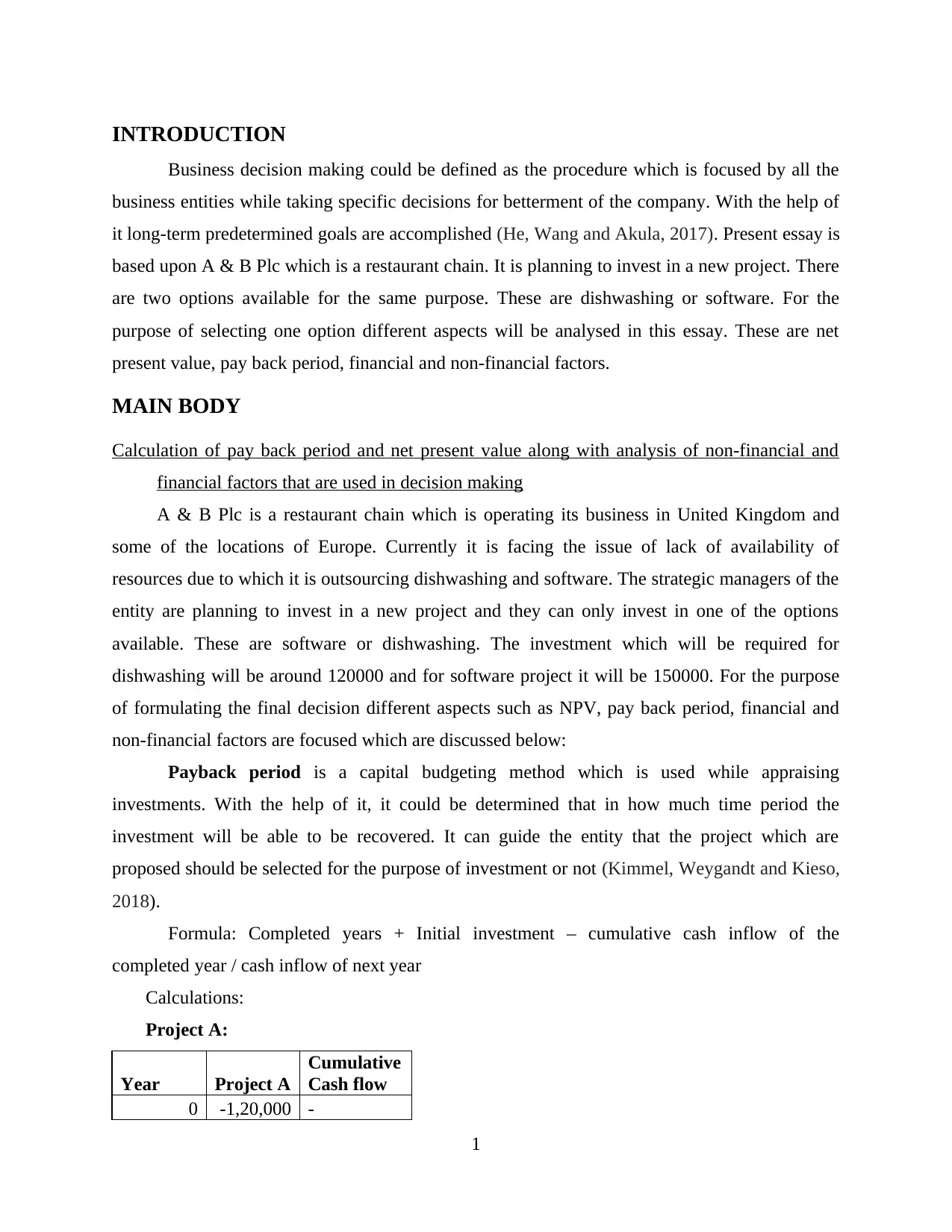
INTRODUCTION
Business decision making could be defined as the procedure which is focused by all the
business entities while taking specific decisions for betterment of the company. With the help of
it long-term predetermined goals are accomplished (He, Wang and Akula, 2017). Present essay is
based upon A & B Plc which is a restaurant chain. It is planning to invest in a new project. There
are two options available for the same purpose. These are dishwashing or software. For the
purpose of selecting one option different aspects will be analysed in this essay. These are net
present value, pay back period, financial and non-financial factors.
MAIN BODY
Calculation of pay back period and net present value along with analysis of non-financial and
financial factors that are used in decision making
A & B Plc is a restaurant chain which is operating its business in United Kingdom and
some of the locations of Europe. Currently it is facing the issue of lack of availability of
resources due to which it is outsourcing dishwashing and software. The strategic managers of the
entity are planning to invest in a new project and they can only invest in one of the options
available. These are software or dishwashing. The investment which will be required for
dishwashing will be around 120000 and for software project it will be 150000. For the purpose
of formulating the final decision different aspects such as NPV, pay back period, financial and
non-financial factors are focused which are discussed below:
Payback period is a capital budgeting method which is used while appraising
investments. With the help of it, it could be determined that in how much time period the
investment will be able to be recovered. It can guide the entity that the project which are
proposed should be selected for the purpose of investment or not (Kimmel, Weygandt and Kieso,
2018).
Formula: Completed years + Initial investment – cumulative cash inflow of the
completed year / cash inflow of next year
Calculations:
Project A:
Year Project A
Cumulative
Cash flow
0 -1,20,000 -
1
Business decision making could be defined as the procedure which is focused by all the
business entities while taking specific decisions for betterment of the company. With the help of
it long-term predetermined goals are accomplished (He, Wang and Akula, 2017). Present essay is
based upon A & B Plc which is a restaurant chain. It is planning to invest in a new project. There
are two options available for the same purpose. These are dishwashing or software. For the
purpose of selecting one option different aspects will be analysed in this essay. These are net
present value, pay back period, financial and non-financial factors.
MAIN BODY
Calculation of pay back period and net present value along with analysis of non-financial and
financial factors that are used in decision making
A & B Plc is a restaurant chain which is operating its business in United Kingdom and
some of the locations of Europe. Currently it is facing the issue of lack of availability of
resources due to which it is outsourcing dishwashing and software. The strategic managers of the
entity are planning to invest in a new project and they can only invest in one of the options
available. These are software or dishwashing. The investment which will be required for
dishwashing will be around 120000 and for software project it will be 150000. For the purpose
of formulating the final decision different aspects such as NPV, pay back period, financial and
non-financial factors are focused which are discussed below:
Payback period is a capital budgeting method which is used while appraising
investments. With the help of it, it could be determined that in how much time period the
investment will be able to be recovered. It can guide the entity that the project which are
proposed should be selected for the purpose of investment or not (Kimmel, Weygandt and Kieso,
2018).
Formula: Completed years + Initial investment – cumulative cash inflow of the
completed year / cash inflow of next year
Calculations:
Project A:
Year Project A
Cumulative
Cash flow
0 -1,20,000 -
1
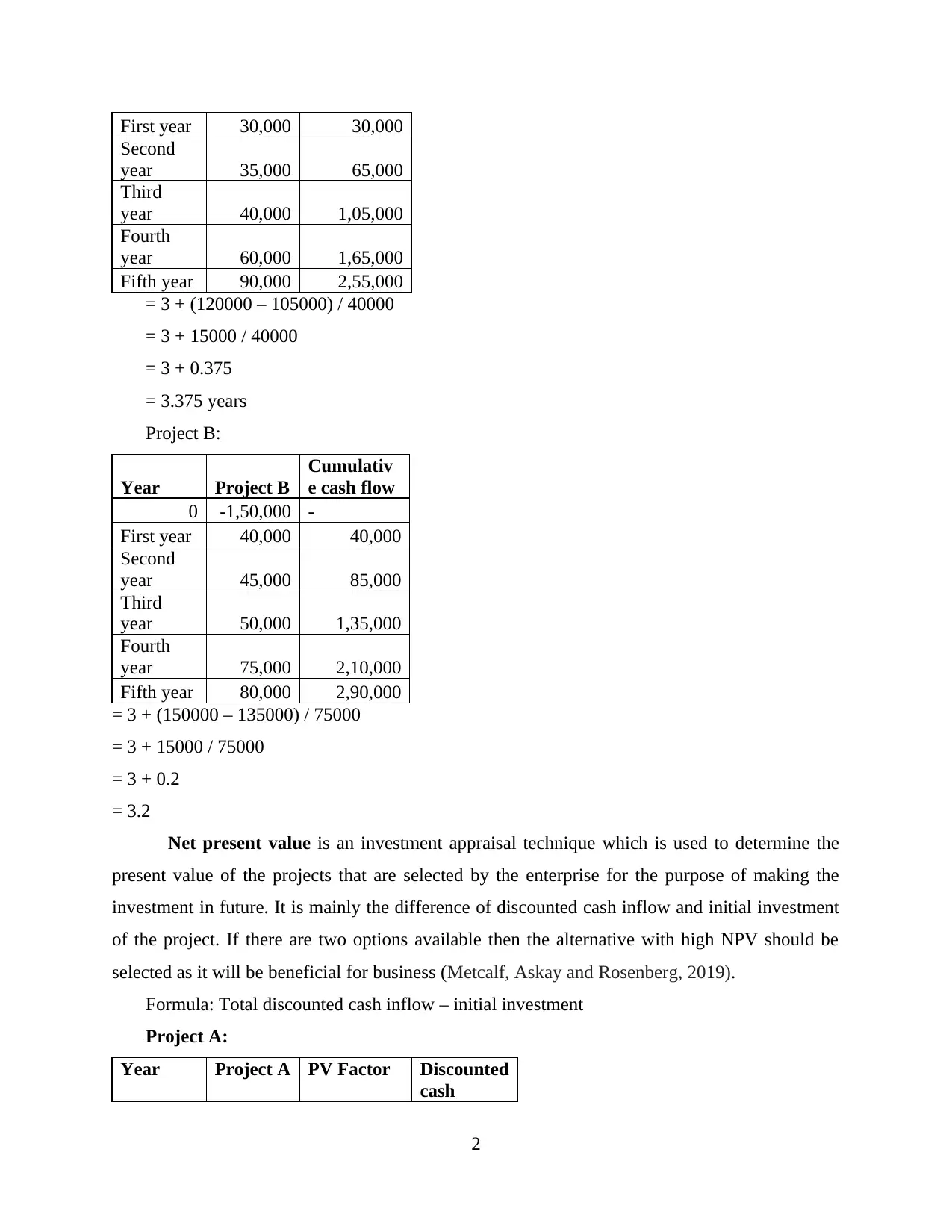
First year 30,000 30,000
Second
year 35,000 65,000
Third
year 40,000 1,05,000
Fourth
year 60,000 1,65,000
Fifth year 90,000 2,55,000
= 3 + (120000 – 105000) / 40000
= 3 + 15000 / 40000
= 3 + 0.375
= 3.375 years
Project B:
Year Project B
Cumulativ
e cash flow
0 -1,50,000 -
First year 40,000 40,000
Second
year 45,000 85,000
Third
year 50,000 1,35,000
Fourth
year 75,000 2,10,000
Fifth year 80,000 2,90,000
= 3 + (150000 – 135000) / 75000
= 3 + 15000 / 75000
= 3 + 0.2
= 3.2
Net present value is an investment appraisal technique which is used to determine the
present value of the projects that are selected by the enterprise for the purpose of making the
investment in future. It is mainly the difference of discounted cash inflow and initial investment
of the project. If there are two options available then the alternative with high NPV should be
selected as it will be beneficial for business (Metcalf, Askay and Rosenberg, 2019).
Formula: Total discounted cash inflow – initial investment
Project A:
Year Project A PV Factor Discounted
cash
2
Second
year 35,000 65,000
Third
year 40,000 1,05,000
Fourth
year 60,000 1,65,000
Fifth year 90,000 2,55,000
= 3 + (120000 – 105000) / 40000
= 3 + 15000 / 40000
= 3 + 0.375
= 3.375 years
Project B:
Year Project B
Cumulativ
e cash flow
0 -1,50,000 -
First year 40,000 40,000
Second
year 45,000 85,000
Third
year 50,000 1,35,000
Fourth
year 75,000 2,10,000
Fifth year 80,000 2,90,000
= 3 + (150000 – 135000) / 75000
= 3 + 15000 / 75000
= 3 + 0.2
= 3.2
Net present value is an investment appraisal technique which is used to determine the
present value of the projects that are selected by the enterprise for the purpose of making the
investment in future. It is mainly the difference of discounted cash inflow and initial investment
of the project. If there are two options available then the alternative with high NPV should be
selected as it will be beneficial for business (Metcalf, Askay and Rosenberg, 2019).
Formula: Total discounted cash inflow – initial investment
Project A:
Year Project A PV Factor Discounted
cash
2
Secure Best Marks with AI Grader
Need help grading? Try our AI Grader for instant feedback on your assignments.
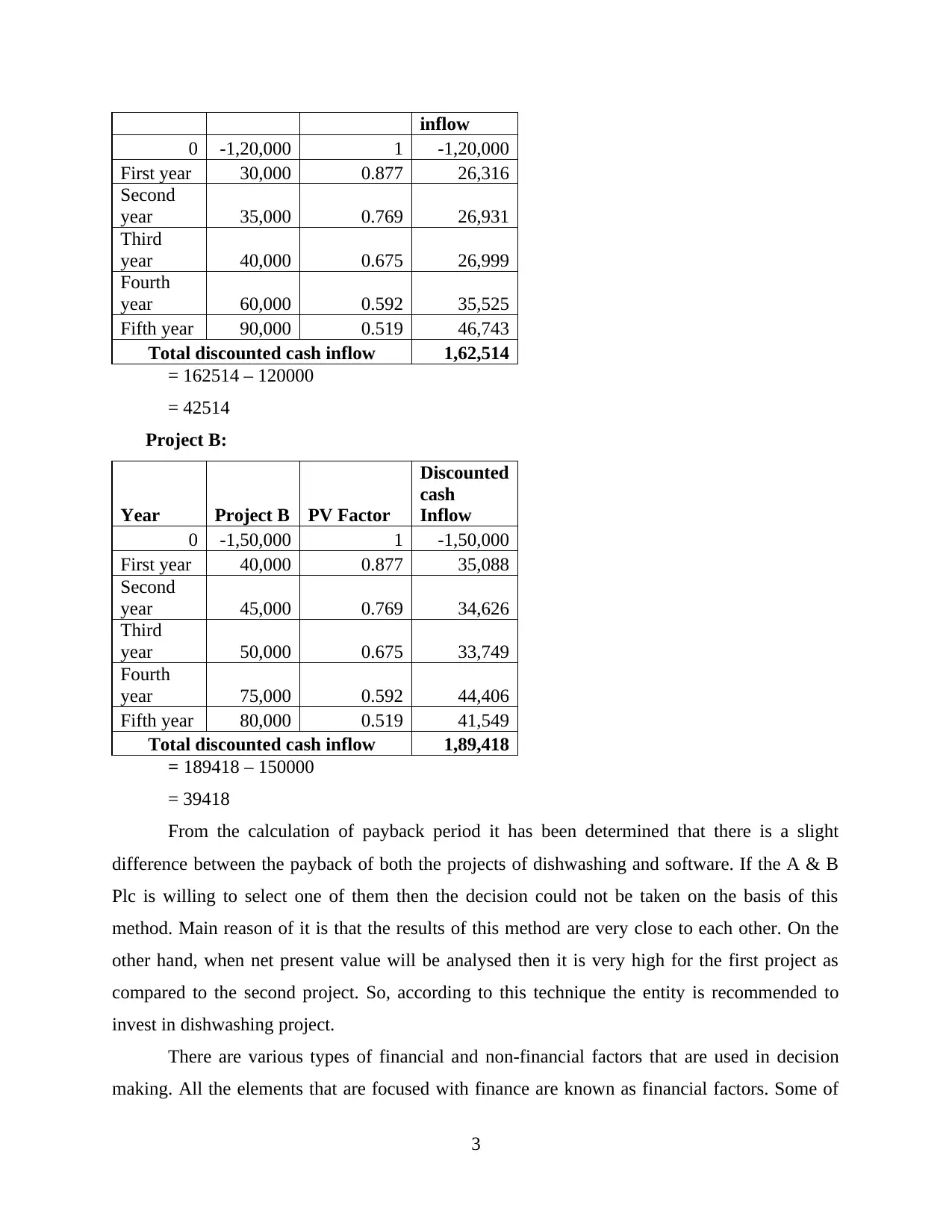
inflow
0 -1,20,000 1 -1,20,000
First year 30,000 0.877 26,316
Second
year 35,000 0.769 26,931
Third
year 40,000 0.675 26,999
Fourth
year 60,000 0.592 35,525
Fifth year 90,000 0.519 46,743
Total discounted cash inflow 1,62,514
= 162514 – 120000
= 42514
Project B:
Year Project B PV Factor
Discounted
cash
Inflow
0 -1,50,000 1 -1,50,000
First year 40,000 0.877 35,088
Second
year 45,000 0.769 34,626
Third
year 50,000 0.675 33,749
Fourth
year 75,000 0.592 44,406
Fifth year 80,000 0.519 41,549
Total discounted cash inflow 1,89,418
= 189418 – 150000
= 39418
From the calculation of payback period it has been determined that there is a slight
difference between the payback of both the projects of dishwashing and software. If the A & B
Plc is willing to select one of them then the decision could not be taken on the basis of this
method. Main reason of it is that the results of this method are very close to each other. On the
other hand, when net present value will be analysed then it is very high for the first project as
compared to the second project. So, according to this technique the entity is recommended to
invest in dishwashing project.
There are various types of financial and non-financial factors that are used in decision
making. All the elements that are focused with finance are known as financial factors. Some of
3
0 -1,20,000 1 -1,20,000
First year 30,000 0.877 26,316
Second
year 35,000 0.769 26,931
Third
year 40,000 0.675 26,999
Fourth
year 60,000 0.592 35,525
Fifth year 90,000 0.519 46,743
Total discounted cash inflow 1,62,514
= 162514 – 120000
= 42514
Project B:
Year Project B PV Factor
Discounted
cash
Inflow
0 -1,50,000 1 -1,50,000
First year 40,000 0.877 35,088
Second
year 45,000 0.769 34,626
Third
year 50,000 0.675 33,749
Fourth
year 75,000 0.592 44,406
Fifth year 80,000 0.519 41,549
Total discounted cash inflow 1,89,418
= 189418 – 150000
= 39418
From the calculation of payback period it has been determined that there is a slight
difference between the payback of both the projects of dishwashing and software. If the A & B
Plc is willing to select one of them then the decision could not be taken on the basis of this
method. Main reason of it is that the results of this method are very close to each other. On the
other hand, when net present value will be analysed then it is very high for the first project as
compared to the second project. So, according to this technique the entity is recommended to
invest in dishwashing project.
There are various types of financial and non-financial factors that are used in decision
making. All the elements that are focused with finance are known as financial factors. Some of
3
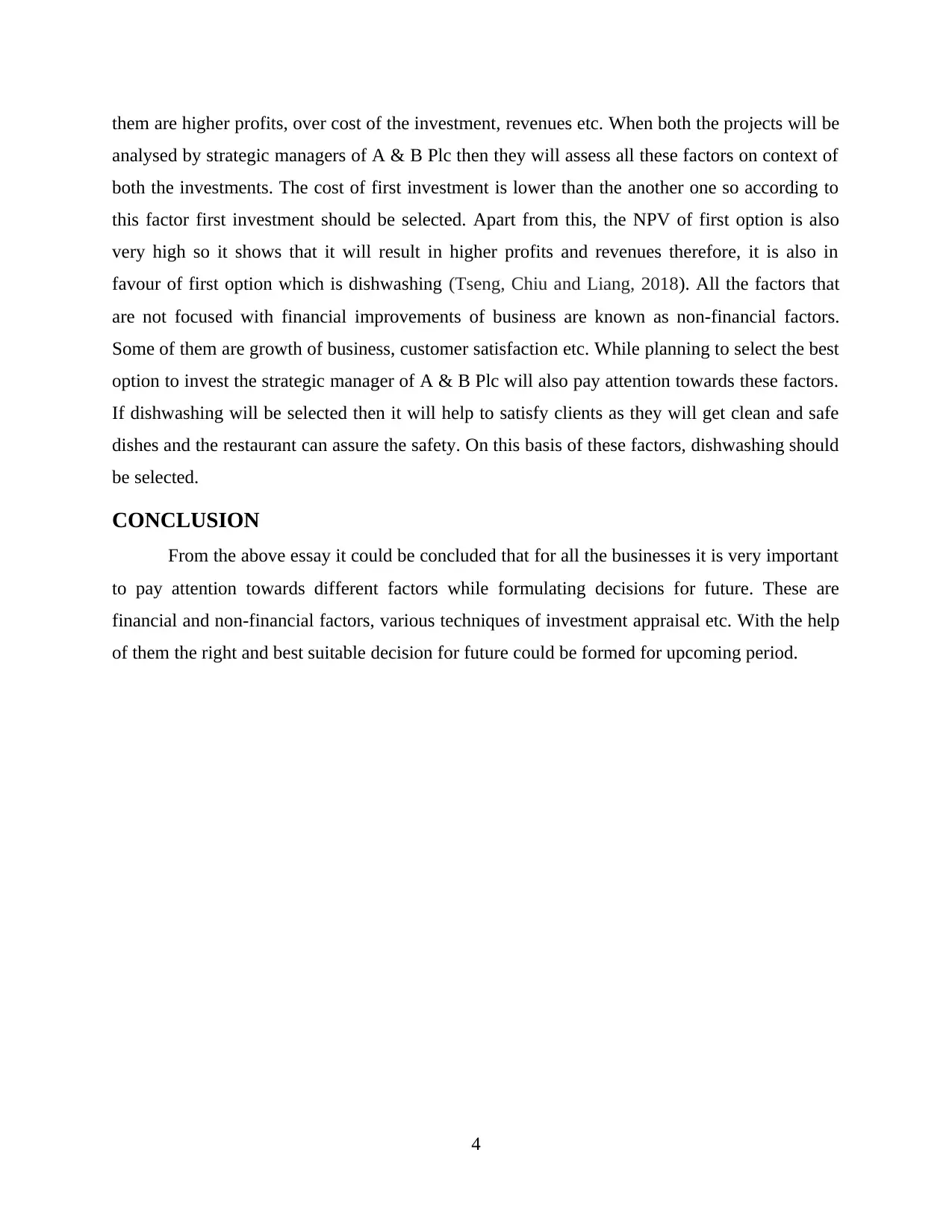
them are higher profits, over cost of the investment, revenues etc. When both the projects will be
analysed by strategic managers of A & B Plc then they will assess all these factors on context of
both the investments. The cost of first investment is lower than the another one so according to
this factor first investment should be selected. Apart from this, the NPV of first option is also
very high so it shows that it will result in higher profits and revenues therefore, it is also in
favour of first option which is dishwashing (Tseng, Chiu and Liang, 2018). All the factors that
are not focused with financial improvements of business are known as non-financial factors.
Some of them are growth of business, customer satisfaction etc. While planning to select the best
option to invest the strategic manager of A & B Plc will also pay attention towards these factors.
If dishwashing will be selected then it will help to satisfy clients as they will get clean and safe
dishes and the restaurant can assure the safety. On this basis of these factors, dishwashing should
be selected.
CONCLUSION
From the above essay it could be concluded that for all the businesses it is very important
to pay attention towards different factors while formulating decisions for future. These are
financial and non-financial factors, various techniques of investment appraisal etc. With the help
of them the right and best suitable decision for future could be formed for upcoming period.
4
analysed by strategic managers of A & B Plc then they will assess all these factors on context of
both the investments. The cost of first investment is lower than the another one so according to
this factor first investment should be selected. Apart from this, the NPV of first option is also
very high so it shows that it will result in higher profits and revenues therefore, it is also in
favour of first option which is dishwashing (Tseng, Chiu and Liang, 2018). All the factors that
are not focused with financial improvements of business are known as non-financial factors.
Some of them are growth of business, customer satisfaction etc. While planning to select the best
option to invest the strategic manager of A & B Plc will also pay attention towards these factors.
If dishwashing will be selected then it will help to satisfy clients as they will get clean and safe
dishes and the restaurant can assure the safety. On this basis of these factors, dishwashing should
be selected.
CONCLUSION
From the above essay it could be concluded that for all the businesses it is very important
to pay attention towards different factors while formulating decisions for future. These are
financial and non-financial factors, various techniques of investment appraisal etc. With the help
of them the right and best suitable decision for future could be formed for upcoming period.
4
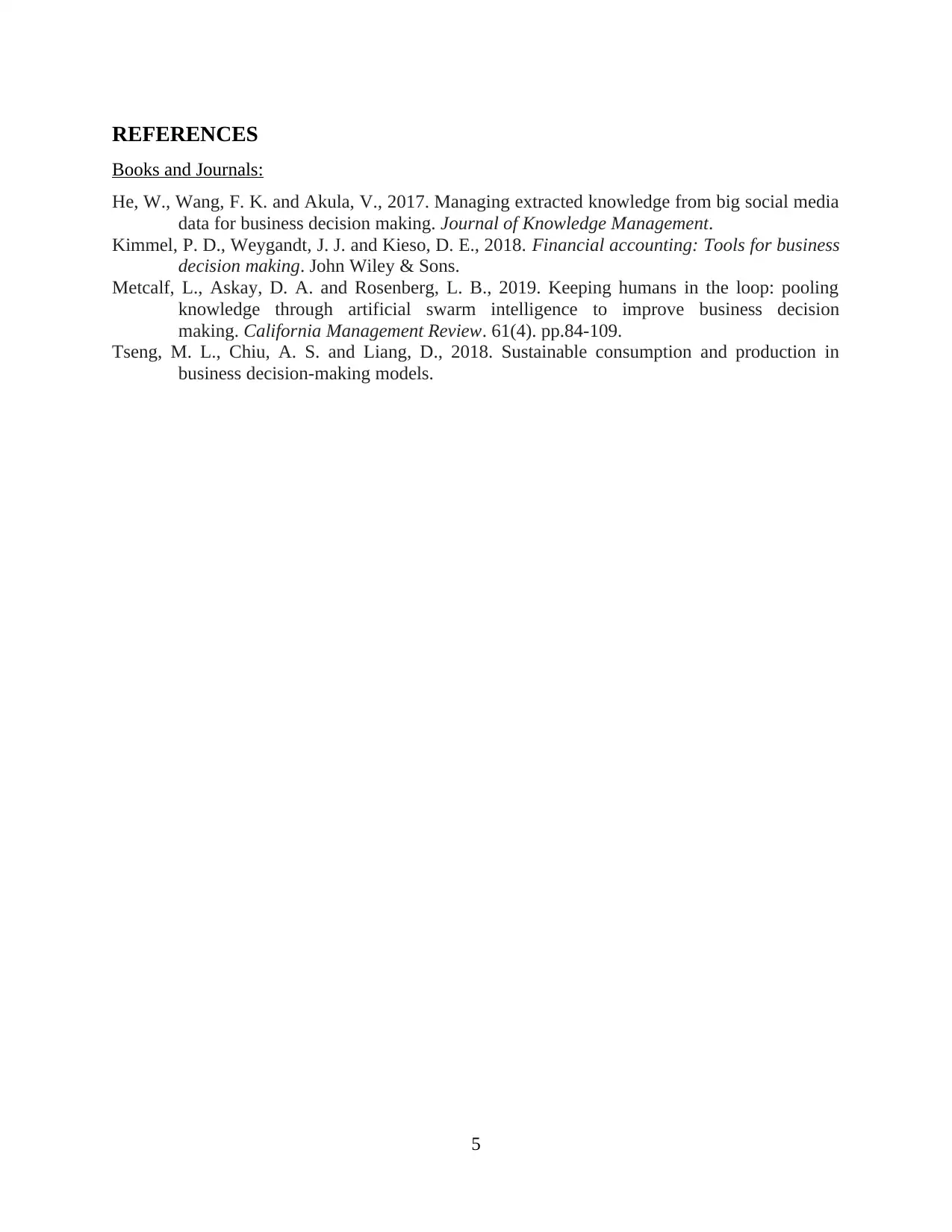
REFERENCES
Books and Journals:
He, W., Wang, F. K. and Akula, V., 2017. Managing extracted knowledge from big social media
data for business decision making. Journal of Knowledge Management.
Kimmel, P. D., Weygandt, J. J. and Kieso, D. E., 2018. Financial accounting: Tools for business
decision making. John Wiley & Sons.
Metcalf, L., Askay, D. A. and Rosenberg, L. B., 2019. Keeping humans in the loop: pooling
knowledge through artificial swarm intelligence to improve business decision
making. California Management Review. 61(4). pp.84-109.
Tseng, M. L., Chiu, A. S. and Liang, D., 2018. Sustainable consumption and production in
business decision-making models.
5
Books and Journals:
He, W., Wang, F. K. and Akula, V., 2017. Managing extracted knowledge from big social media
data for business decision making. Journal of Knowledge Management.
Kimmel, P. D., Weygandt, J. J. and Kieso, D. E., 2018. Financial accounting: Tools for business
decision making. John Wiley & Sons.
Metcalf, L., Askay, D. A. and Rosenberg, L. B., 2019. Keeping humans in the loop: pooling
knowledge through artificial swarm intelligence to improve business decision
making. California Management Review. 61(4). pp.84-109.
Tseng, M. L., Chiu, A. S. and Liang, D., 2018. Sustainable consumption and production in
business decision-making models.
5
1 out of 7
Related Documents
Your All-in-One AI-Powered Toolkit for Academic Success.
+13062052269
info@desklib.com
Available 24*7 on WhatsApp / Email
![[object Object]](/_next/static/media/star-bottom.7253800d.svg)
Unlock your academic potential
© 2024 | Zucol Services PVT LTD | All rights reserved.





